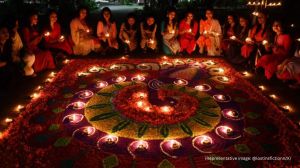Laurie Baker, for whom home was extension of land, dies at 90
So impressed was Gandhi with this Royal Navy hand’s shoes stitched from scraps, he asked him if he would build homes for the poor

The Briton who turned the canons of conventional homemaking on their head and became one of India’s greatest living architectural legends, is no more. Laurie Baker, 90, passed away at his Thiruvanantapuram home this morning after prolonged illness. He will be buried tomorrow.
The boy from a middle class home in Birmingham who studied architecture in London, Baker came to India accidentally during the height of the Second World War, on board a British warship that he served on. The ship happened to get stuck in Mumbai while returning from China. Baker loved recounting how he used those three months in Mumbai to go around and study the city’s architecture, and then called on the man who changed his life forever — Mahatma Gandhi.
Gandhi took an amused look at the young Briton, more particularly at his homemade shoes that Baker had cleverly sewn together from discarded cloth bits and a thrown-away sole. Gandhi smiled and asked him to return to India once out of the Royal Navy, and if he could use that kind of ingenuity in architecture to help build homes for India’s poor. “That changed everything. I may have been overawed by him but he made tremendous sense,” Baker told this reporter a few years ago.
He came back to India in 1945 with a British missionary team working among leprosy patients in Faizabad, helping build cheap but sturdy, functional homes, the first of the internationally acclaimed Baker homes. He made friends with a Keralite doctor involved in rehabilitation efforts for leprosy patients in north Indian villages — and then his sister Dr Elizabeth, a missionary doctor working in Hyderabad. He married Elizabeth and moved to Thiruvanantapuram.
Over the next 50 years, Baker designed and built thousands of homes, each bearing his unmistakable signature, and each built mostly with material available locally and blending with the local environment and ambience. All were shorn of ostentatious or alien elements, but were extremely functional aesthetic delights as well. He built them for everyone, from porters to leaders and bureaucrats, destitutes to billionaires, in ones and twos and in hundreds and more.
“To my mind, a home should be a smooth extension of the land it is on, it shouldn’t stick out. I made my own like a blanket hugging this hillock”, he had once said, waving at his Thiruvanantapuram home that doesn’t alter the steep landscape on which it sits, even notionally.
In Kerala, his brand of homemaking reoriented the Malayali back towards what he had strayed away from, weaning him away from a flush of NRI remittances translating into garish concrete monstrosities.
He taught Kerala how homes could be built at a fraction of the cost that they usually spent, without interfering with nature, environment, traditions and comforts.
Down the years, COSTFORD, an organization manned and run by Baker’s disciples in Kerala, have been furthering the reach of his ideas all over the country — for everything, from rebuilding villages destroyed in calamities in some part of the country to building huge architectural showpieces elsewhere.
Governments all over had vied to have him on various housing and architecture committees, ranging from the Planning Commission, HUDCO, NID, CBRI and a host of other national bodies.
Laurels came from abroad as well, including from the Royal Netherlands University which conferred a D Litt on him in 1981.
But for many long years, Baker was pained and disappointed that his repeated attempts to get an Indian citizenship were spurned year after year — it was only in 1991 that the Government finally thought he could be allowed an Indian citizenship, and backed it up with a Padmashri award as well.



- 01
- 02
- 03
- 04
- 05




























